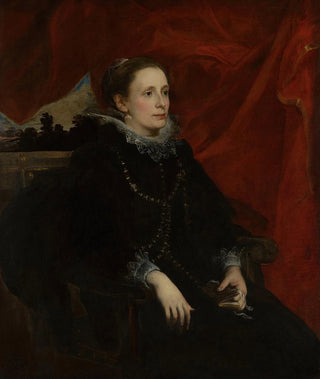Art print | Portrait of a woman called the Marquise Durazzo - Antoine van Dyck


View from behind

Frame (optional)
Portrait of a Woman Called the Marquise Durazzo - Antoine van Dyck – Captivating Introduction
In the world of art, certain works transcend time and space, capturing the very essence of their era while resonating with future generations. The "Portrait of a Woman Called the Marquise Durazzo" by Antoine van Dyck is one of those creations that, through its beauty and depth, invites prolonged contemplation. This painting, created in the 17th century, not only showcases the undeniable talent of its artist but also reflects the elegance and refinement of a period when art and nobility intertwined harmoniously. The marquise, an emblematic figure of high society, reveals herself to us through the penetrating gaze of Van Dyck, offering a window into a bygone world while remaining strangely contemporary.
Style and uniqueness of the work
Van Dyck's style is recognizable among a thousand, characterized by an exceptional mastery of light and color. In this portrait, the Marquise Durazzo is depicted with unmatched grace, her delicate features and dignified expression capturing the viewer's attention. The color palette chosen by the artist, blending warm tones and soft shadows, creates an intimate and refined atmosphere. Every detail, from the sumptuous drapery of her dress to the shimmering jewelry adorning her neck, demonstrates a keen sense of observation and an ability to render the texture of materials with striking precision. The composition, both balanced and dynamic, allows the figure of the marquise to come to life, almost as if she were about to step out of the painting and mingle with our reality.
The artist and his influence
Antoine van Dyck, a pupil of Rubens, established himself as one of the most influential portraitists of his time. His stint at the court of England as the official painter of Charles I marked a turning point in his career, enabling him to develop a style that combines elegance and intimacy. Van Dyck was able to capture not only the physical appearance of his subjects but also their personality, making his portraits deeply human works. His influence endures in the history of art, inspiring

Matte finish

View from behind

Frame (optional)
Portrait of a Woman Called the Marquise Durazzo - Antoine van Dyck – Captivating Introduction
In the world of art, certain works transcend time and space, capturing the very essence of their era while resonating with future generations. The "Portrait of a Woman Called the Marquise Durazzo" by Antoine van Dyck is one of those creations that, through its beauty and depth, invites prolonged contemplation. This painting, created in the 17th century, not only showcases the undeniable talent of its artist but also reflects the elegance and refinement of a period when art and nobility intertwined harmoniously. The marquise, an emblematic figure of high society, reveals herself to us through the penetrating gaze of Van Dyck, offering a window into a bygone world while remaining strangely contemporary.
Style and uniqueness of the work
Van Dyck's style is recognizable among a thousand, characterized by an exceptional mastery of light and color. In this portrait, the Marquise Durazzo is depicted with unmatched grace, her delicate features and dignified expression capturing the viewer's attention. The color palette chosen by the artist, blending warm tones and soft shadows, creates an intimate and refined atmosphere. Every detail, from the sumptuous drapery of her dress to the shimmering jewelry adorning her neck, demonstrates a keen sense of observation and an ability to render the texture of materials with striking precision. The composition, both balanced and dynamic, allows the figure of the marquise to come to life, almost as if she were about to step out of the painting and mingle with our reality.
The artist and his influence
Antoine van Dyck, a pupil of Rubens, established himself as one of the most influential portraitists of his time. His stint at the court of England as the official painter of Charles I marked a turning point in his career, enabling him to develop a style that combines elegance and intimacy. Van Dyck was able to capture not only the physical appearance of his subjects but also their personality, making his portraits deeply human works. His influence endures in the history of art, inspiring






